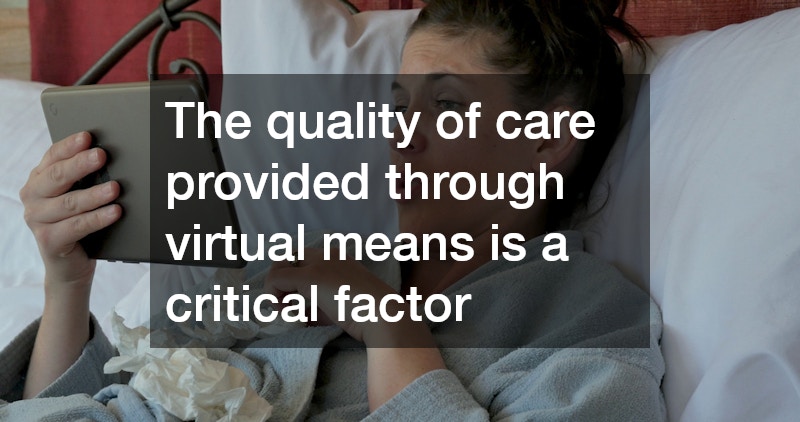
Virtual care has revolutionized the way healthcare is delivered, leveraging technology to provide medical services remotely. With the advent of the internet and advancements in communication technologies, virtual care has become a viable option for patients and healthcare providers alike. It includes a broad spectrum of health-related services, from telemedicine consultations to remote monitoring of patients.
These services offer a new level of convenience, making it easier for patients to access medical advice without the need to physically visit a clinic. The goal is to enhance accessibility, especially for those in remote or underserved areas, while maintaining a high standard of care.
The rise of virtual care can be attributed to the need for more efficient healthcare delivery systems that can cater to the growing patient population. As travel becomes a barrier for many to receive timely healthcare, virtual care bridges this gap by bringing healthcare to the patient’s fingertips. It is beneficial not only in rural settings but also in urban environments, where time constraints and lifestyle factors can impede regular healthcare visits. Through virtual platforms, patients can schedule appointments, receive diagnoses, manage medications, and even undergo follow-up visits. This level of accessibility has the potential to improve patient outcomes by facilitating quicker interventions and ongoing care.
Virtual care also plays a significant role in chronic disease management, wherein continuous monitoring and timely interventions are crucial. Devices that can track heart rates, blood pressure, and glucose levels, among other vital signs, are part of the virtual care toolkit. The data collected by these devices can be transmitted to healthcare providers in real time, allowing for immediate action if necessary. This capability not only reassures patients but also empowers clinicians with the information needed to make informed decisions. By optimizing appointment schedules and minimizing unnecessary travel, virtual care helps streamline healthcare processes, leading to enhanced efficiency and effectiveness in patient management.
The Impact on Quality of Care
The quality of care provided through virtual means is a critical factor in determining the effectiveness of this healthcare model. Virtual care has demonstrated its capability to deliver high-quality care, especially in areas where direct access to healthcare is limited. Studies have shown that virtual consultations can often lead to faster diagnosis and treatment plans, as patients are more likely to seek medical help when it is more accessible. This proactive approach can lead to better health outcomes, as issues are addressed before they become severe complications. However, the perceived depersonalization in virtual interactions remains a concern for some patients.
Despite these concerns, many patients report high satisfaction levels with virtual care, citing convenience, time savings, and reduced travel as significant benefits. The instantaneous nature of virtual consultations means that patients can receive care without the long waiting times typical of in-person appointments. Moreover, virtual care eliminates geographical barriers, allowing patients to access specialists and experts who might not be available locally. This wide range of accessible healthcare options can often lead to more comprehensive and specialized care solutions, tailored to individual patient needs. As healthcare systems adapt to integrate more technology, patient education and adaptability are also crucial in maximizing the benefits of virtual care.
Another dimension of quality care through virtual means is the level of personalization and continued patient engagement. Virtual care platforms often have features that enhance patient interaction through follow-up reminders, medication notifications, and lifestyle modification recommendations. These tools can help sustain patient involvement in their own health management, leading to improved adherence to treatment plans and preventive care measures. Furthermore, the integration of artificial intelligence-driven tools can offer personalized insights and predictive analytics that inform patient care strategies. Overall, while virtual care strives to mimic the patient-centered approach of traditional healthcare, its success relies heavily on the seamless integration with existing healthcare practices and continued patient support.
Challenges and Considerations
Despite its potential, virtual care faces several challenges that need addressing to ensure it delivers on its promise of improved quality of care. One of the significant concerns is ensuring data privacy and security, as patient information is transmitted and stored online. Healthcare providers must adhere to stringent data protection regulations to maintain patient trust and confidentiality. Moreover, not all patients are equally equipped to access virtual care services, with disparities in technology access and digital literacy posing significant hurdles. Addressing these gaps is essential to prevent exacerbating existing inequalities in healthcare access and outcomes.
Another challenge in the widespread adoption of virtual care is ensuring that the quality of interactions does not decline. The absence of physical examinations in a virtual setting can pose limitations in diagnosing certain conditions that require touch and direct observation. Healthcare providers must develop innovative solutions and rely on patients’ accurate self-reports to bridge this gap effectively. Training and equipping patients with remote monitoring tools can improve data accuracy and reliability. Additionally, continuous professional training for healthcare providers on virtual care platforms can enhance their ability to conduct effective and accurate remote assessments.
Lastly, the regulatory landscape for virtual care is still evolving, with different regions having varying requirements and policies. These inconsistencies can create complexities in delivering standardized care across state or national borders. Collaborative efforts among stakeholders, including policymakers, healthcare providers, and technology developers, are crucial in creating cohesive frameworks. These frameworks should promote safe, efficient, and equitable access to virtual care services while ensuring compliance with healthcare standards. By overcoming these challenges, virtual care can secure its role as a pivotal element in modern healthcare ecosystems, ultimately enhancing patient outcomes and operational efficiencies.





